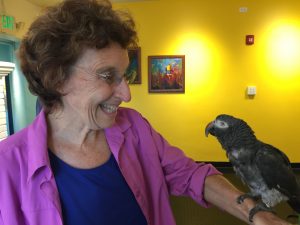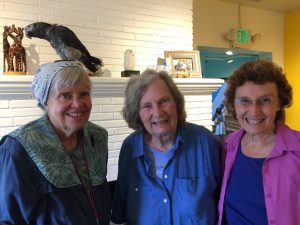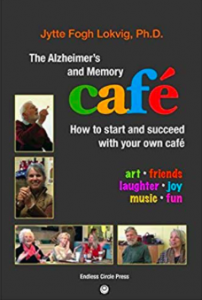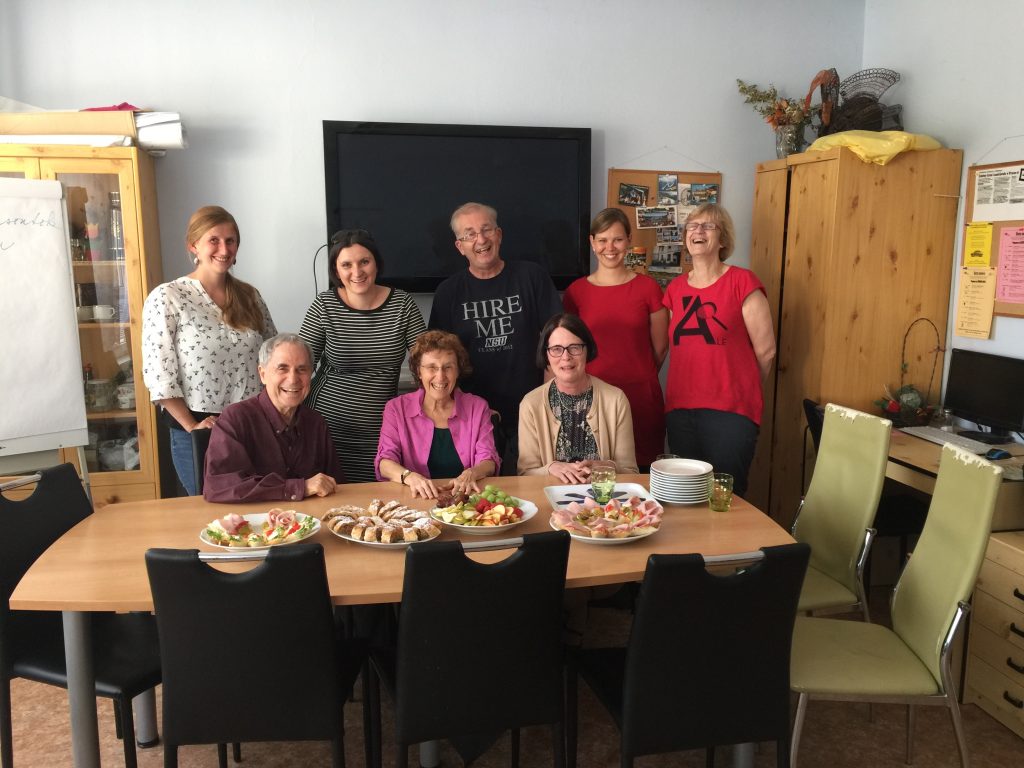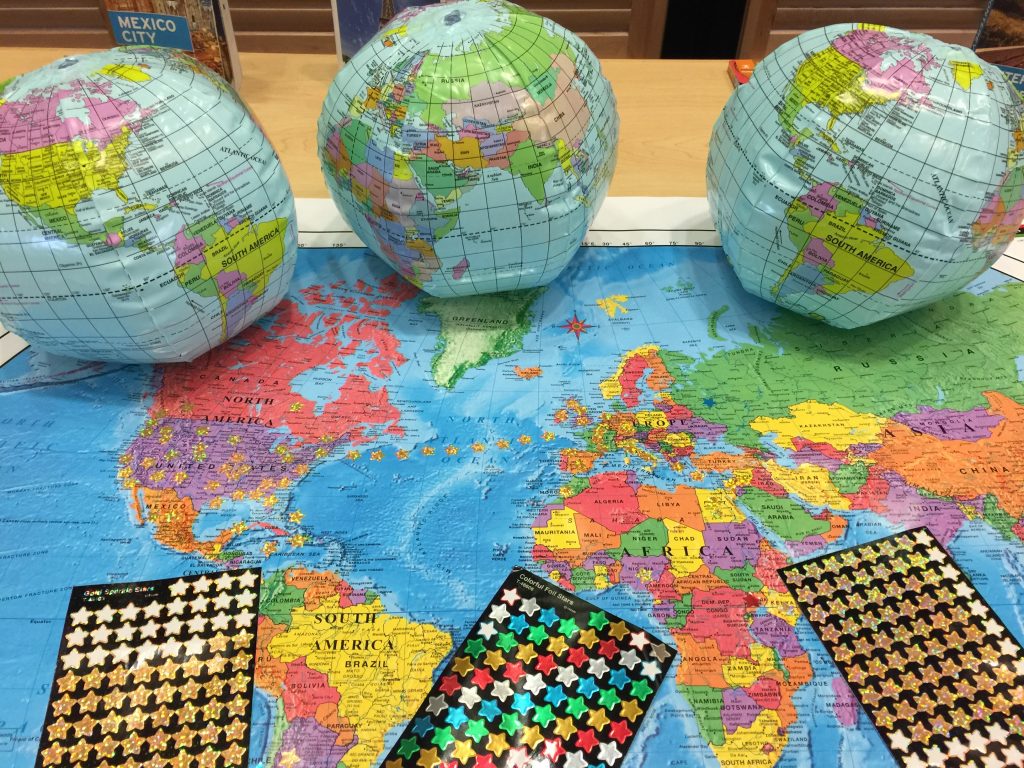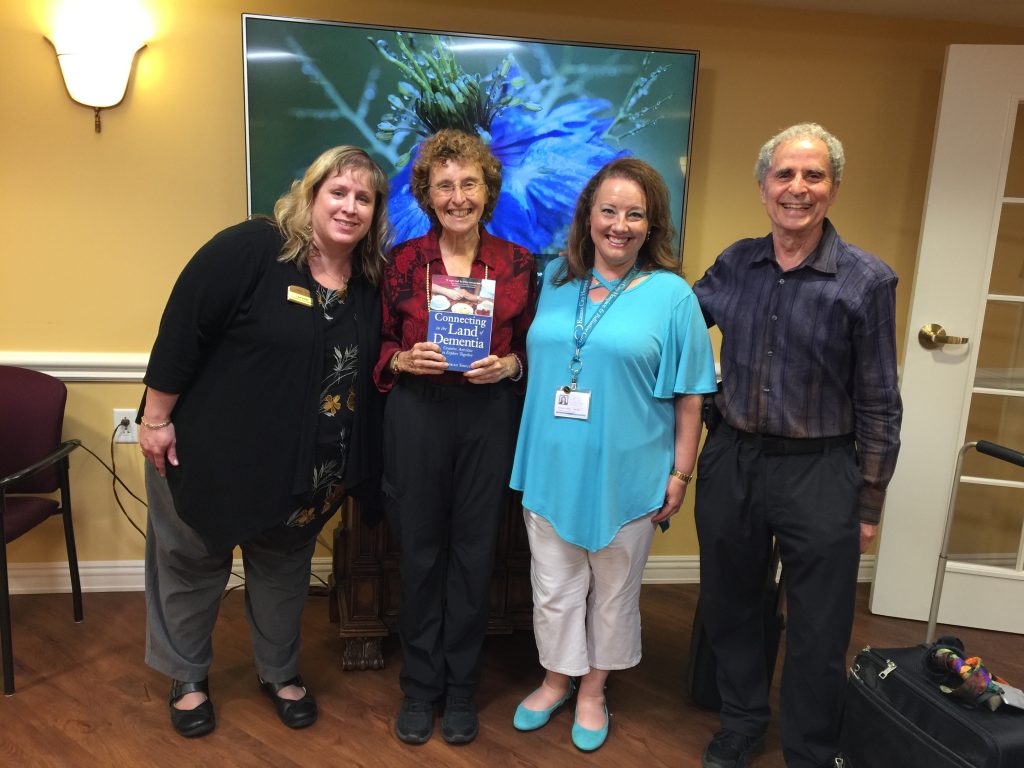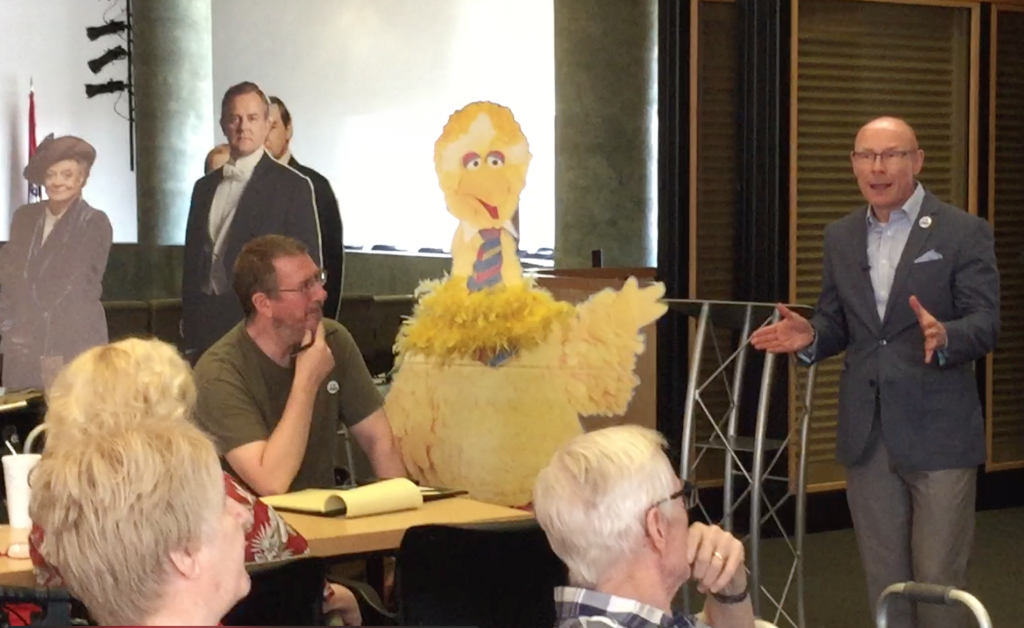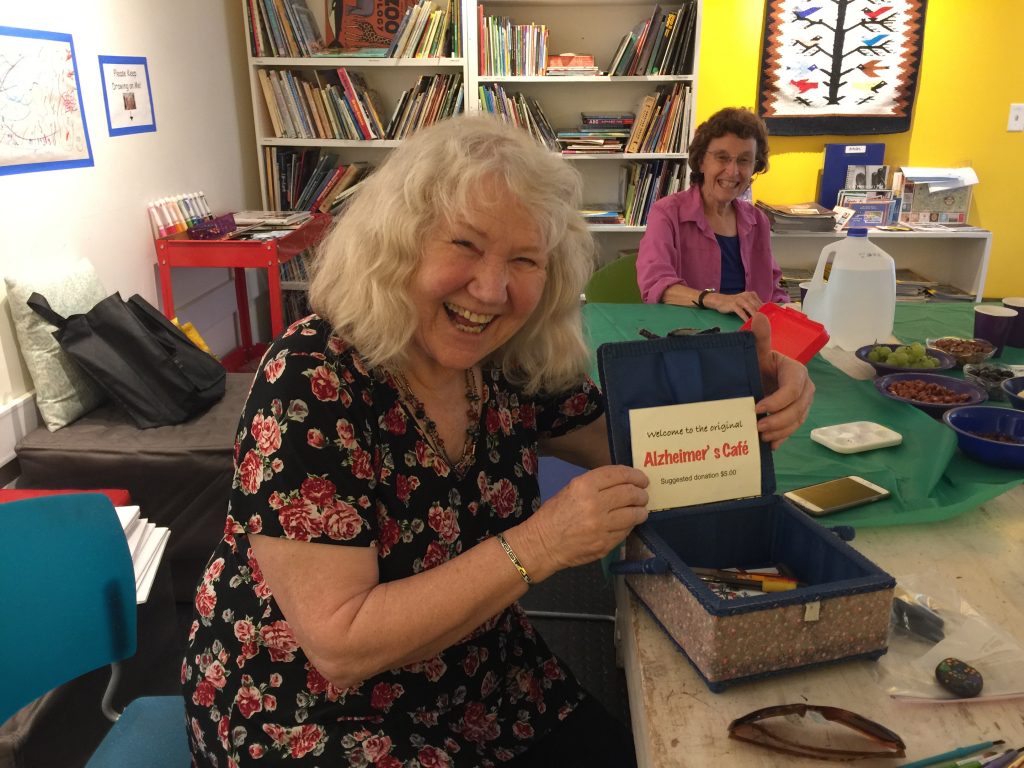An Old-Fashioned Holiday
This old-fashioned holiday story from Love in the Land of Dementia: Finding Hope in the Caregiver’s Journey celebrates the spiritual aspects of living with dementia.
When I walk through the doors of the nursing home, I find my mother in her wheelchair, right in front of the medication cart, right behind the central nursing station, where nurses, delivery people, staff and family members congregate. Mom is bent over, her baby doll lying across her lap. When I walk up to her, I ratchet up my energy and widen my smile. I am preparing to clown her into a reaction.
Later my father will ask if I think she recognized me.
“No,” I will have to tell him. “She did not recognize me. But she did smile.”
The smile is important.
My hand waving and head bobbing does its work: Mom does smile, and I can tell she is in her own current version of a good mood.
“Music in the dining room,” the activity board reads, so I wheel her in that direction. An elderly man with a red and white trimmed Santa hat passes us in the hallway.
“Look Mom, there’s Santa,” I tell her.
Having been brought up Jewish, Mom never was all that enthralled with the Claus mythology and she has not changed.
A white-haired woman is in the dining room, busily setting up for the music program. Several patients are already gathered. The woman takes out a microphone, a boom box, an illuminated plastic snowman, and a small silver bell. I continue wheeling Mom down the far corridor, liking the sense of companionship I have from this movement.
As we stroll, a nurse carrying a plate of lettuce walks past us.
“She must have been a good mother,” she says, nodding at the way Mom is holding the baby. “She must still be a good mother.”
“She is,” I say.
I have never really said to my mom, “You were a good mother.”
Now I realize she was.
I can see that Mom is enjoying the ride. She loved movement when she was younger and was far more adventuresome than Dad when it came to airplanes, ski lifts, fast cars, and speedy boats. For her, biting breeze across the face was thrilling, not threatening. Until she became a mother, that is. Then she abandoned her pleasure in the heights and speed and concentrated on making sure we were slow, safe, and centered.
We roll back into the dining room just as the show is ready to start. The singer, Thelda, kicks off her shoes and presses play on the boom box. Above the cheerful sound track, she sings Jingle Bells. She dances across the room with the remnants of ballroom steps. She stops in front of Mom and sings right to her. She gets on her knees, so she can look into Mom’s eyes, and keeps singing. Mom notices her and smiles a little.
Thelda moves on, singing to each of the patients gathered around, so intent on making a connection that she often forgets the words.
“Is it all right for your Mom to come to Christmas holiday events?” the activity director had asked me, when Mom moved from the memory care into the skilled care portion of the nursing home.
“Yes, I’d like her to go to any activities. She likes the extra energy.”
I think Mom would approve of my decision, even though she has never celebrated Christmas. Growing up, her immigrant mother held on to the Jewish spirit of her home, kneading dough for Friday evening challah, observing each holiday and prayer period in her own way. Some orthodox women followed the religious law that commanded a small piece of the dough be burned as an offering to God. My grandmother was poor; she did not believe in burning good food, regardless of tradition. So she sacrificed a portion of the dough to her youngest daughter, my mother Fran. She created a “bread tail,” leftover dough that she smeared with butter and sprinkled with sugar and baked. When Mom used to talk about her mother, she always mentioned this special treat.
Even when I was growing up, and we were the only Jewish family in our neighborhood, my mother still did not sing Christmas songs. She did not willingly go to Christmas parties. She let the holiday rush by her, like a large train, whooshing past, ruffling her hair and leaving her behind.
Now, I am singing Christmas carols to my Mom for the first time. She is smiling, though really not at me. But I am sitting beside her while she is smiling and that makes me happy. She has moved beyond the place where the religions are different, beyond the place where she wants to separate the dough and make a sacrifice for tradition. Her new tradition is anyone who can make her smile.
With each song, from White Christmas, to Silver Bells, to Frosty the Snowman, Thelda moves back to Mom, tapping her, nudging her, shaking a bell almost in her face, acting sillier and sillier. Each time, Mom lifts her head and widens her mouth for a second.
For her finale, Thelda puts on a big red nose and sings Rudolph. When she dances in front of Mom with that nose, Mom laughs. For several minutes, Mom stays fixated on the scarlet nose, her face a miracle in pure enjoyment. I laugh too, so delighted to see Mom engaged and absorbed. Then, Thelda dances away and Mom’s face glazes back over.
Two weeks from now, I will bring a menorah and candles into my mother’s room. My father and I will have a short Chanukah ceremony with Mom. She will pick at the shiny paper covering the Chanukah gelt (chocolate candy disguised as money). She will slump over in her chair. But she will come back to life when she sees me, her only daughter, wearing a big red nose as I light the menorah.
Deborah Shouse is the author of Connecting in the Land of Dementia: Creative Activities to Explore Together and Love in the Land of Dementia: Finding Hope in the Caregiver’s Journey.
Eight Steps to Help People Living with Dementia Feel at Ease during Holiday Gatherings
As we move into the holiday season, Ron and I think often of our parents who went through their last holidays with dementia: my mom Frances and his father Frank. We wanted to share the season with them in ways that felt safe, comfortable, and honoring so we gradually developed these tips. Recently, we shared the tips via email and had such a great response we also want to share them with you.
Several people wrote, “These ideas are good for anyone, not just those with memory loss.”
What great wisdom–to treat each person with the tenderness and consideration that we often reserve for someone going through a physical or emotional illness.
We’d like to share our tips and we’d like to learn from you: what other suggestions do you have for helping people feel connected at gatherings?
Eight Steps to Help People Living with Dementia Feel at Ease during Holiday Gatherings
- When you’re in a group, help the person living with dementia feel safe and comfortable by having a trusted friend or family member stay beside him or her, explaining the proceedings and fielding questions from others, as needed.
- Encourage people to say their name and maintain eye contact when conversing with the person who is living with dementia.
- Make sure the person can come and go from the group as needed. Create a quiet space where he or she can rest — or appoint a caring person to drive your loved one home when he tires of the festivities.
- Have something special for them to look at, like a family photo album or a favorite magazine.
- Choose background music that is familiar to them, music of their era played in a style they resonate with.
- Prepare a few of their favorite foods.
- When talking to them, don’t correct or contradict or try to pull them into the current reality. Simply listen carefully and let them talk.
- Appreciate them for who they are right now.
Here’s to a holiday season filled with grace, gratitude and generosity.

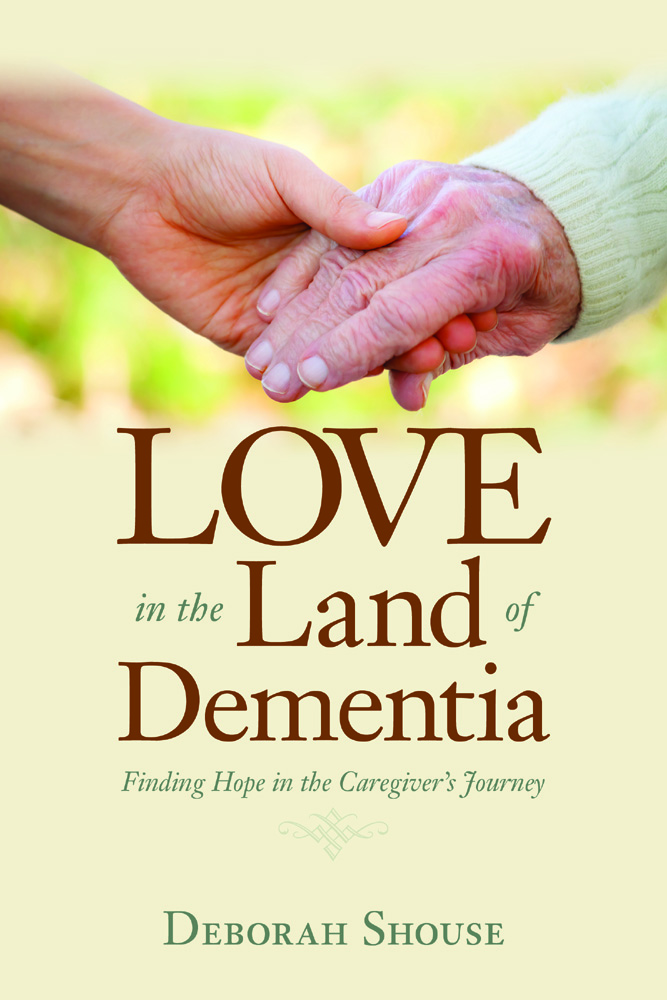
Deborah Shouse is the author of Love in the Land of Dementia: Finding Hope in the Caregiver’s Journey.
A Thanksgiving Love Story: Bringing Home the Gravy
Thanksgiving changed the year I went vegetarian. I did not mind giving up the tender, moist turkey or the savory oyster-specked stuffing. But giving up the flavorful flow of mushroom-laden gravy was quite another thing. I watched enviously as my family ladled the luscious liquids over their mashed potatoes, turkey and stuffing. As I nibbled dryly on my carrots, green beans and salad, my lower lip protruded. I felt left out and deprived.
My brother, Dan, ever alert to the pouting big sister, came up with a solution.
“Next year I will make special vegetarian gravy just for you,” Dan promised.
Years later, that special vegetarian gravy has become one of my favorite Thanksgiving rituals. I begin fantasizing about it the moment the autumn leaves turn crimson. I know that in mere weeks, my brother and his family will arrive and I will have my yearly boost of family and feasting, highlighted by gravy.
When my brother calls to tell me his travel plans, I write his arrival time and GRAVY on my calendar. The night he comes to town, we make the shopping list together, avidly discussing how many pounds of mushrooms we need for both the carnivore and vegetarian pots of gravy. I relish the early-Wednesday morning trip through the grocery store, where Dan and I and our children carefully select the foods we will be making the next day. We linger in the produce aisle, filling several sacks with gleaming white mushrooms and buying rustling yellow onions.
On Thanksgiving Day, Dan and I and other family members spend long, luxurious hours cooking. Dan mans the stove and I manage the slicing and chopping. Together we snap, peal, slice and dice the vegetables that will accessorize the turkey. I take special pleasure in wiping clean and slicing the mushrooms, then bringing my brother the brimming bowlful. When he has nodded his approval, I get out the old copper pot I bought in Germany in the early seventies. This year, Dan is improving his already amazing gravy. With his new immersion blender, he creates a rich base of caramelized onions, whose flavor surpasses that of the lowly vegetable cube. He adds in a little flour, then gentles the mushrooms into the onion broth. When the pot is bubbling with thickening nectar, he says, “Taste this and see what you think.”
I always think the same thing—“Wow, this is great.”
We are in a state of giddy and satisfied exhaustion by the time our guests arrive. We share grateful prayers with everyone and lay out the feast, including plenty of turkey-based gravy for the rest of the family.
Then comes the moment I have been waiting for: I sit down, my own personal pot of gravy poised by my plate. I cover the mashed potatoes, carrots, green beans, and salad with the aromatic concoction and I savor every bite. But more importantly, I savor the bounty, creativity, and love that have gone into this simple dish. Through this gravy, my brother speaks with his hands and his heart, saying: “I care about you and I am going to make sure you are not left out and that you have something fantastic to eat.”
For that and so much more, I am thankful.
…………
And now, if you’d like to create a Thanksgiving love story, bring home this delicious gravy.
Dan Barnett’s Chicago Style Never-Enough-Mushroom Vegetarian Gravy
Ingredients
2 large onions (chopped)
2 pounds (or more) white button mushrooms sliced (can add some portabellas for enhanced flavor)
1 cup of white wine (of lesser quality)
Salt & pepper to taste
Olive oil
Directions
To create the gravy base:
In a four -quart pot, pour a thin layer of olive oil and turn the burner on medium.
Add the onions and sauté for10-15 minutes until they are caramelized (golden brown)
Add water until the pot is about half full.
Simmer slowly for 30 minutes.
Blend the onion water mixture using either an immersion blender or by transferring the mixture to a food processor.
Once you have the gravy base
Add the 2 pounds (or more) of sliced mushrooms, white wine and fill the pot with water until it is 3/4 full.
Simmer for 30 minutes and season to taste with salt and pepper.
Deborah Shouse is the author of Connecting in the Land of Dementia: Creative Activities to Explore Together and Love in the Land of Dementia: Finding Hope in the Caregiver’s Journey.
Dementia Arts to Draw us Together
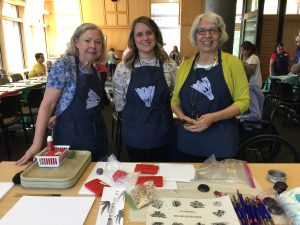 September’s Memory Cafe featured a lively team of educators from the Nelson-Atkins Museum of Art. Using the arts to draw us together, they showed us the Chinese art form of painting pictures of bamboo. About fifty of us gathered in the the library’s spacious lower level. Colorful plastic cloths covered our tables, making it easy to distinguish our drawing paper and painting supplies.
September’s Memory Cafe featured a lively team of educators from the Nelson-Atkins Museum of Art. Using the arts to draw us together, they showed us the Chinese art form of painting pictures of bamboo. About fifty of us gathered in the the library’s spacious lower level. Colorful plastic cloths covered our tables, making it easy to distinguish our drawing paper and painting supplies. 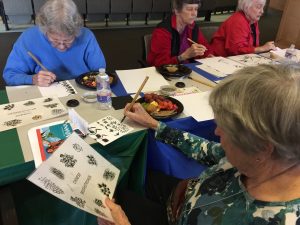 All of us eagerly dipped our special bamboo brushes into the ebony paint and made short pushing movements, replicating segments of the plant’s stalk. Then our educators showed us drawings of bamboo foliage and we experimented with wispy thin lines of leaves.
All of us eagerly dipped our special bamboo brushes into the ebony paint and made short pushing movements, replicating segments of the plant’s stalk. Then our educators showed us drawings of bamboo foliage and we experimented with wispy thin lines of leaves.
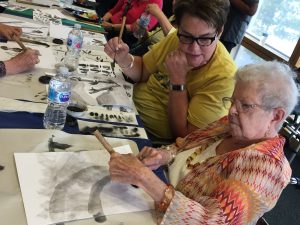 Our common ground continued as our teacher said, “Now, we’re going to pass out large sheets of paper.” We all oohed and aahed and let our strokes grow larger and more confident. At the end, each person created a design in a small wedge of clay, pressed the clay into a red stamp pad, and adorned the painting with our own personal “signature.”
Our common ground continued as our teacher said, “Now, we’re going to pass out large sheets of paper.” We all oohed and aahed and let our strokes grow larger and more confident. At the end, each person created a design in a small wedge of clay, pressed the clay into a red stamp pad, and adorned the painting with our own personal “signature.”• To add extra meaning, connect the artistic activity with something in your partner’s past.
• Invite an intergenerational mixture of artists, from children, grandchildren, art students, and volunteers to join your partner and add encouragement. 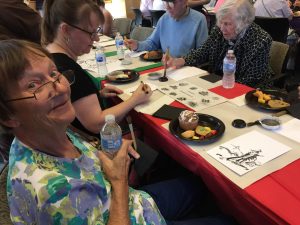
• Create a variety of art-related activities, including visiting galleries or looking at pictures from magazines, as well as painting, drawing or various media.


Czech Mates in Dementia Care: Laughter Yoga in Prague
The table was spread with an array of Czech delicacies: apple strudel, special sandwiches with flowers of ham atop fresh baguettes, a bountiful tray of strawberries, grapes, and apple slices. 
“This is the way we welcome people here in Prague,” said Lucie Hajkova, social worker and coordinator of respite care for the Czech Alzheimer’s Society.
Ron and I were visiting the Gerontological Centre and the Czech Alzheimer’s Society, which are both housed in the same building. The two organizations work together to offer clients everything they need, from psychological counseling, to memory testing, to social work services, to healthcare. We came to learn and to present a laughter yoga session.
We gathered with staff members around the table to learn about the center, which was started in 1997 by Iva 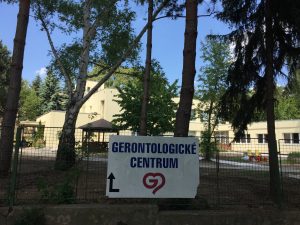 Holmerova, MD. along with Hana Janeckova, PhD. Hana was putting together training materials for caregivers when she was contacted by Alzheimer’s Disease International. They wanted to know more about her work and they invited her to an international conference in Jerusalem. That conference was a turning point. Hana left it inspired and determined to help Czech families that were dealing with dementia. She contacted Iva and both saw the need to offer education, diagnosis, support, and care for people living with dementia and their families in the Czech Republic. Today, both centers are flourishing.
Holmerova, MD. along with Hana Janeckova, PhD. Hana was putting together training materials for caregivers when she was contacted by Alzheimer’s Disease International. They wanted to know more about her work and they invited her to an international conference in Jerusalem. That conference was a turning point. Hana left it inspired and determined to help Czech families that were dealing with dementia. She contacted Iva and both saw the need to offer education, diagnosis, support, and care for people living with dementia and their families in the Czech Republic. Today, both centers are flourishing.
We were impressed with the dementia services they offered, which included home care for people who need help with bathing, dressing, eating, exercise or more. The building holds a respite center. When families need renewal time, or when people living with dementia need extra care or healing time, they can stay in respite for up to a month. The Centre also hosts a day program that offers a variety of activities in a homey and comfortable setting,
Even more impressive than the Society’s services were its staff. Each had a passion for this work, a love for those who are living with dementia, and a compassion for their families.

We had a wonderful time sharing a laughing session at the day center—our first international facilitation. We sat in a beautiful circle of people living with dementia, staff, family, and friends. We couldn’t have done it without our translator, Eliska, who captured the energy and essence of what we were saying. And once we all started laughing, we were beyond the constraints of language. Click here to experience a bit of laughter in Prague.

Photo Caption:
Eliska Brouckova, psychologist, consultant/advisor for people with dementia and their care givers
Martina Matlova, Director
Petr Veleta, PhD, dancer, dance therapist
Marketa Splichalova, psychologist, consultant/advisor for people with dementia and their care givers
Eva Jarolimova, PhD, psychologist, consultant for people with dementia and their care givers
Hana Janeckova, PhD, co- founder of the Czech Alzheimer Society, head of governing board of Czech Alzheimer Society, University teacher, researcher
Lucie Hajkova, social worker, coordinator of respite care in homes of people with dementia.


Movies and Memories: Traveling the World Without Leaving Kansas City:
“I’ve traveled the world. Our family moved a lot when we were young,” one of our guests told us, at our August Movies and Memories program. She and her husband bent over our world map and stuck stars on some of the many places 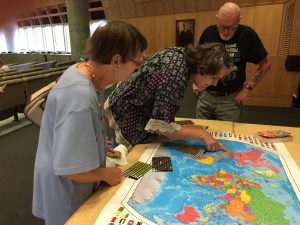 they’d lived. Another guest sighed when he looked at the map and saw Vietnam. He had served in the military there. A couple talked about living in Berlin when the Wall came down.
they’d lived. Another guest sighed when he looked at the map and saw Vietnam. He had served in the military there. A couple talked about living in Berlin when the Wall came down.
Our Movies and Memories travel films included forays into Paris, Iceland, Capetown, and Seoul.
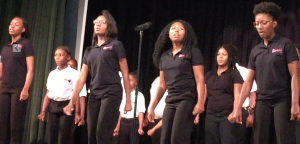 “It was relaxing just watching the scenes from Paris,” said Ah’Lee Robinson, director of the Kansas City Boys and Girls Choirs. He and his singers treated us to an inspiring concert, warming us up for the films.
“It was relaxing just watching the scenes from Paris,” said Ah’Lee Robinson, director of the Kansas City Boys and Girls Choirs. He and his singers treated us to an inspiring concert, warming us up for the films.
“Oh dear, now I want to go to Iceland,” another guest said.
In between clips, we passed around exotic spices for everyone to smell. At the end of the movies and memories adventure, everyone took home a special “Passport” booklet, created by the library’s Emily Cox, so they could record impressions and memories. To experience the event, click here.
Here are some passport questions to discuss at home: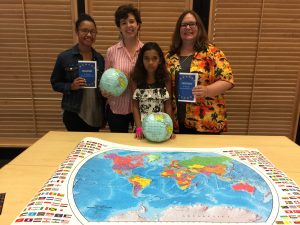
Share some travel memories.
What is one of the most beautiful places you’ve ever visited?
What’s the farthest you’ve ever traveled?
What country has the best food?
How many of the US states have you visited?
Thanks to our wonderful volunteers, Sharon and Julie, who brighten our events by bringing treats, making popcorn, and making everyone feel so at home.
Thanks to Craig Eichelman, State Director, AARP, for helping us spread the word about this program.
 We are so grateful for the continuing support from the Kansas City Public Library. They are amazing champions for people who are living with dementia and their care partners. They also provide scholarships for hard-working people whose higher education has been interrupted by life circumstances. Their community programs benefit early readers, job seekers, and people who are new to KC. Ron and I use their books and other services every week!
We are so grateful for the continuing support from the Kansas City Public Library. They are amazing champions for people who are living with dementia and their care partners. They also provide scholarships for hard-working people whose higher education has been interrupted by life circumstances. Their community programs benefit early readers, job seekers, and people who are new to KC. Ron and I use their books and other services every week!
Please join us for our next adventure — Moana. This movie is so inspiring and great for all ages.
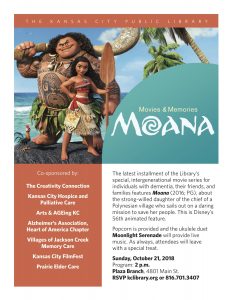


Celebrating Great Connectors Throughout the Dementia Journey: Music, Nature, and Laughter
When care partners gather and trade stories and ideas, there’s usually magic afoot. We felt that magic when we met with a group of family and professional care partners to celebrate great connectors throughout the dementia journey. We presented engaging ideas using music, nature, laughter and more.
Lisa Vetter, Director of Healthcare Sales & Marketing, Santa Marta Senior Living Community, invited us to speak at an event announcing the community’s new care partner support group. The group is led by Jennifer Walker, RN, BSN, Clinical Community Liaison, Kansas City Hospice & Palliative Care. Jennifer also facilitates the KC Memory Cafe and she is compassionate, informed, and smart. Most importantly, she has a fantastic sense of humor.
Ron and I shared ways to stay connected through singing and music, looking at works of art together, bringing nature indoors, and laughing. And our audience shared their experiences as well.
Here’s a story about nature that inspired us.
Marcie took her mom, who was living with dementia, on a fascinating monthly outing: they drove out into the country to look at the full moon. Her mother didn’t talk much anymore, but she loved seeing the night sky and gazing at the magnificent moon. One evening, as the moonlight spread over the car, Mom began singing, When the moon comes over the mountain. Marcie had never heard the song before and her eyes filled with tears at hearing her mom sing so strongly and clearly.
Here’s a story about the power of familiar music. Karen’s mom was a devout Catholic, living with dementia. Though there were many things she didn’t remember, including her daughter’s name, when she attended Sunday mass, she melodically sang every word of every hymn.
We loved sharing with this group of dedicated and compassionate care partners, who were all seeking ways to stay connected.
Here’s an extra tip from Connecting in the Land of Dementia: When you want to boost energy and lift spirits, add a splash of laughter into your life. Look at a clock and say, “We’re going to laugh for 30 seconds,” and start ha ha ha-ing. Or pretend you’re talking on the phone and hearing a hilarious joke. Or warble out the Ha Ha Chorus by singing the Happy Birthday song in “ha ha ha” syllables.


How Has Television Shaped Our Lives: Insights from Nick Haines, KCPT
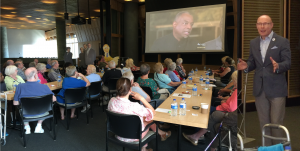 How has television shaped our lives? Nick Haines, Executive Producer Public Affairs/News, at KCPT, helped us count the ways at our August Memory Cafe. Fifty people joined us for this witty and illuminating program, including some PBS favorites: Big Bird and the stars of Downton Abbey. Nick began by showing us a few of the 20 most iconic TV clips of our time, including the space landing, Johnny Carson’s farewell show, and the tragedy of 9-11.
How has television shaped our lives? Nick Haines, Executive Producer Public Affairs/News, at KCPT, helped us count the ways at our August Memory Cafe. Fifty people joined us for this witty and illuminating program, including some PBS favorites: Big Bird and the stars of Downton Abbey. Nick began by showing us a few of the 20 most iconic TV clips of our time, including the space landing, Johnny Carson’s farewell show, and the tragedy of 9-11.
Then we moved onto commercials. Does anybody remember when people dressed up to get on an airplane and domestic flights served hot food on real china dishes? How about a young Donald Trump starring in a Burger King commercial? The cafe crowed went crazy over a white-coated MD, starting that he and his colleagues preferred Camel cigarettes.
Nick had us guess the two most popular non-sports TV events. (Mash and Roots.) And he set us laughing with tag lines from various products, such as M&M’s, Frosted Flakes, and Alka Seltzer. 
Nowadays, people watch on so many venues and are often not conversant with the same shows. But during our cafe, we were all tuned into the enjoyment of sharing laughter, memories, and ideas. Thanks to Nick for his great talk and to KCPT for all the marvelous programming and community work they do.
Click here to experience the Cafe
And thanks to all our teammates and community volunteers.
 KCPT is one of the Kansas City Public Library’s many partners in programming. Our library is an amazing champion for people who are living with dementia and their care partners. They also provide scholarships for hard-working people whose higher education has been interrupted by life circumstances. Their programs benefit early readers, job seekers, and people who are new to KC. Ron and I use their books and other services every week!
KCPT is one of the Kansas City Public Library’s many partners in programming. Our library is an amazing champion for people who are living with dementia and their care partners. They also provide scholarships for hard-working people whose higher education has been interrupted by life circumstances. Their programs benefit early readers, job seekers, and people who are new to KC. Ron and I use their books and other services every week!
You don’t need to be artistically inclined to enjoy our next cafe on September 21st. We hope you can join us.
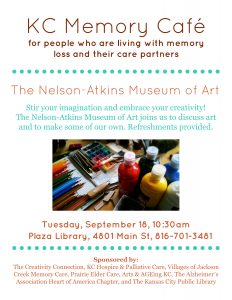



International Insights: Caring in Croatia
 Even before Tomislav (Tom) Huić, Vice president of Alzheimer Croatia had a personal involvement with dementia, he was helping the Croatia Alzheimer’s Society with their marketing. As a professional marketer and co-founder of a successful ad agency, he wanted to help the fledgling, all-volunteer non-profit, and he often offered them his professional expertise. Then his mother began having memory issues and Tom became more involved. Today, he is one of the three full-time volunteers who run the 20-year-old agency.
Even before Tomislav (Tom) Huić, Vice president of Alzheimer Croatia had a personal involvement with dementia, he was helping the Croatia Alzheimer’s Society with their marketing. As a professional marketer and co-founder of a successful ad agency, he wanted to help the fledgling, all-volunteer non-profit, and he often offered them his professional expertise. Then his mother began having memory issues and Tom became more involved. Today, he is one of the three full-time volunteers who run the 20-year-old agency.
We met with Tom at the Hemingway Bar and Cafe in Zagreb, Croatia,  wanting to learn more about ways the society was educating and assisting people across the country and the region.
wanting to learn more about ways the society was educating and assisting people across the country and the region.
“Every year, we offer a professional workshop,” he says. That workshop, plus donations, provides the Association’s only operating money.
Tom understands the importance of collaboration and education. With a grant from the European Union, he and partners created dementia training materials for nurses. They presented the information to healthcare professionals in parts of Croatia and Slovenia. The programs were well received and he is working on presenting them in other parts of the region.
Tom also created a partnership with pharmacists in Zagreb. When elders came in to pick up medications, they were invited to take a short cognition exam. Sixty percent of the participants failed the test and they were given contact information for the Society. But only a handful of those contacted Tom and his team.
“We still have stigma here,” Tom says. “Plus, many people mistakenly think memory impairment is a natural part of growing older.”
They are collaborating with nursing homes and with governmental health agencies to provide guidelines for memory care beds.
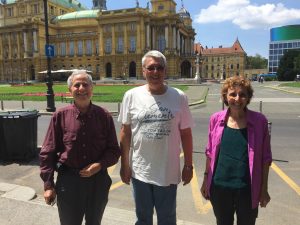 No money. No budget. Lots of ideas. Too few people and too few finances to implement them. The task ahead of Alzheimer Croatia seems daunting. But Tom and his team are not daunted. They are educating family and professional care partners through a variety of pathways, offering much needed information and support.
No money. No budget. Lots of ideas. Too few people and too few finances to implement them. The task ahead of Alzheimer Croatia seems daunting. But Tom and his team are not daunted. They are educating family and professional care partners through a variety of pathways, offering much needed information and support.


Dementia Friendly Cafes: Inviting Creativity and Connection
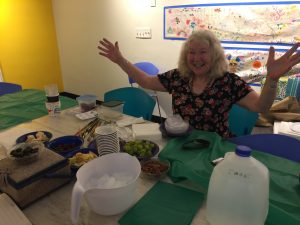 More than 10 years ago, Jytte Lokvig, PhD, was scanning the internet for additional information about dementia. On one of her Google searches she saw the words “Alzheimer’s Cafe” posted by Dr. Bere Miesen, who founded the first Alzheimer’s cafe in Leiden, the Netherlands in 1997. That phrase electrified her. She leapt out of her chair, much to the dismay of her cat, who was cozily sleeping across her feet, and declared, “I am going to make that happen in the U.S.!” She’d been working with people who were living with dementia in community settings for some years, orchestrating art, music, craft and other meaningful projects. But she felt something was missing. That something, she realized, was engagement in the community.
More than 10 years ago, Jytte Lokvig, PhD, was scanning the internet for additional information about dementia. On one of her Google searches she saw the words “Alzheimer’s Cafe” posted by Dr. Bere Miesen, who founded the first Alzheimer’s cafe in Leiden, the Netherlands in 1997. That phrase electrified her. She leapt out of her chair, much to the dismay of her cat, who was cozily sleeping across her feet, and declared, “I am going to make that happen in the U.S.!” She’d been working with people who were living with dementia in community settings for some years, orchestrating art, music, craft and other meaningful projects. But she felt something was missing. That something, she realized, was engagement in the community.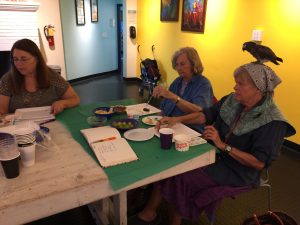 From that inspiration, Jytte created the original U.S. Alzheimer’s Cafe in Santa Fe, NM in 2008. Ten years later, there are more than 300 cafes in the US that invite creativity and connection through dementia friendly cafes.
From that inspiration, Jytte created the original U.S. Alzheimer’s Cafe in Santa Fe, NM in 2008. Ten years later, there are more than 300 cafes in the US that invite creativity and connection through dementia friendly cafes.  “Would you like a round plate of a square one?” she asked.
“Would you like a round plate of a square one?” she asked.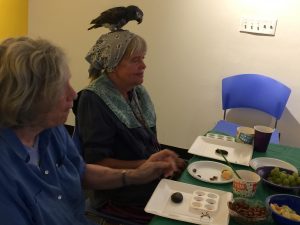
- Arrange a few snacks.
- Invite a guest or two, if you wish. This is an intergenerational project.
- Put a brightly colored plastic covering on the table.
- Squeeze some acrylic paint into a palette. Or use tempura or water colors.
- Offer a choice between two brushes.
- Offer a choice between two canvases: a cardboard paper plate, a river rock, paper, or other.
- Relax and let the painting unfold.
- If your loved ones need a little help, you can paint together. Or you can rest their hand on yours, while you paint to get them used to the movement of the brush.
- Appreciate the art by commenting on the color, the design, the shapes. Don’t ask them to identify the art: enjoy it as it is.
- Weave conversation into your time together.
